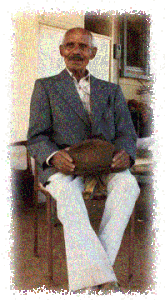The last person who was able to speak Jiwarli fluently was Jack Butler. Jack was born on 4th May 1901 at wilugambal Caraline Creek outcamp, 7 miles west of Maroonah Station (Latitude: -23.35 Longitude: 115.38333) in the north-west of Western Australia.
Jack’s father was Dick Butler, a white shepherd, who later went to Darwin and had two sons there. Dick Butler died at Peak Hill, Western Australia, working in the gold mine there.
Jack’s mother was called Silver in English, and was a Tharrgari woman who worked as shepherd’s cook at Caraline Creek outcamp. Jack’s step-father was Jinabuga a Warriyangka man, who was also referred to as Yawardawari, based on his own father’s name Yawarda (which means ‘horse’ in Jiwarli — he may have been kicked by a horse). His traditional land was Wirndajarri on Alma Station. There are a number of increase sites (called dhalu in Jiwarli) in this traditional country, including jiribarri ‘echidna’, malgurra ‘ground frog’, wunungu ‘boil’, gajalbu ’emu’ and dhurriyardi ‘snake’. Jack was able to speak a number of neighbouring languages fluently, including Warriyangga, Thalanyji, and Jurruru. In 1903 Jack’s brother Joe Butler was born at Yuwiny spring on Ullawarra Station.
All Jiwarli people have a conception totem, which is the plant or animal species that made their mother sick when the spirit child entered her and a baby was conceived. Jack’s conception totem was babalhura a type of small wild potato. It was found at Birdumalgarru by a Jurruru woman called Ngajirany. This place was thus Jack’s conception site.
Aboriginal people in this part of Western Australia belong to one of four sections, which are sociocentric divisions that relate to marriage and descent. Jack’s section was garimarra, meaning that his wife should be banaga and his children would be balyarri. In addition, he belonged to the wariyarra totemic group (groups of people in different patrilineal descent groups who shared a totemic species in common) with the totem of gajalbu ’emu’.
In around 1904 or 1905 Jack and his family moved to Mimburn Glennflorrie Station, where they lived in the Aboriginal camp and travelled extensively throughout Jiwarli traditional territory. In 1906 he experienced an earthquake while travelling with his mother and step-father along the Henry River — the story of this experience was published in Butler & Austin 1986 (in the journal Aboriginal History Vol 10). In 1908 Jack’s sister Molly was born.
As a youngster Jack looked after the Aboriginal men who lived in the old people’s camp. He used to lead them about and wash them. These people included a Jiwarli man called Wanggi, known to the white people as ‘Stumpy’, who was short of stature and left-handed, and Yulgarirri, known to the white people as ‘Billy’, a Nhuwala man who was a rain maker. There was also Wirndangu, known to the white people as ‘Windong’, who was also called Bangiyara because his traditional territory was a place called Bangi. Jack described him as a a copper-coloured, hairless hermaphrodite, and told a story of once being frightened by Windong. It was from these men that Jack learned the Jiwarli language and acquired traditional knowledge, including a number of mythological stories.
In 1923 Jack’s family moved to Gifford Creek Station on the West Lyons River. It was here that Jack’s mayili ‘mother’s father’ called Jimmy died. Jimmy was a Tharrgari man who continued to follow a traditional lifestyle, walking about naked, even in the coldest weather. Jimmy became weak and didn’t eat for fourteen days before he died.
In 1926 Jack moved to Mount Stuart Station whose manager was Harry King. Jack reported that he saw a man in mourning painted with white paint and with a human-hair string around his neck; this was the last time he saw traditional mourning painting used. In 1927 he married Molly Ashburton, a Thalanyji woman, at Mount Stuart Station. Jack’s four children Paul, Maggie, Sid and Claude were born there between 1928 and 1938. From 1939 to 1945 Jack worked as a dingo dogger on Mount Stuart and Bullaloo Stations. He used to ride a pushbike and on several occasions saw bombers flying north. He had a crystal radio and had to come into Onslow to have it registered. In 1953 he separated from Molly Butler, and continued to work on Mount Stuart and other stations.
In 1978 Jack Butler and Peter Austin met in Onslow, Western Australia, and Jack began to teach Peter the Jiwarli language (as well as Warriyangga and Jurruru). Between 1981 and 1985 Austin made various fieldtrips to Carnarvon and Onslow and recorded language material with Jack. On 11th March 1986 Jack travelled to Carnarvon for medical treatment, and was flown to Royal Perth Hospital where terminal intestinal cancer was diagnosed. He returned to Carnarvon after two weeks in hospital and on 24th April 1986 he died at Ingada Village in Carnarvon. On 10th May 1986 he was buried at Carnarvon Cemetery.

[…] Jiwarli speaker […]
LikeLike
[…] Jiwarli speaker […]
LikeLike
[…] Jiwarli speaker […]
LikeLike
[…] Jiwarli speaker […]
LikeLike
[…] Jiwarli speaker […]
LikeLike
[…] Jiwarli speaker […]
LikeLike
[…] Jiwarli speaker […]
LikeLike
[…] Jiwarli speaker […]
LikeLike
[…] Jiwarli speaker […]
LikeLike
[…] Jiwarli speaker […]
LikeLike
[…] Jiwarli speaker […]
LikeLike
[…] Jiwarli speaker […]
LikeLike
[…] Jiwarli speaker […]
LikeLike
[…] Jiwarli speaker […]
LikeLike
[…] Jiwarli speaker […]
LikeLike
[…] Jiwarli speaker […]
LikeLike
[…] Jiwarli speaker […]
LikeLike